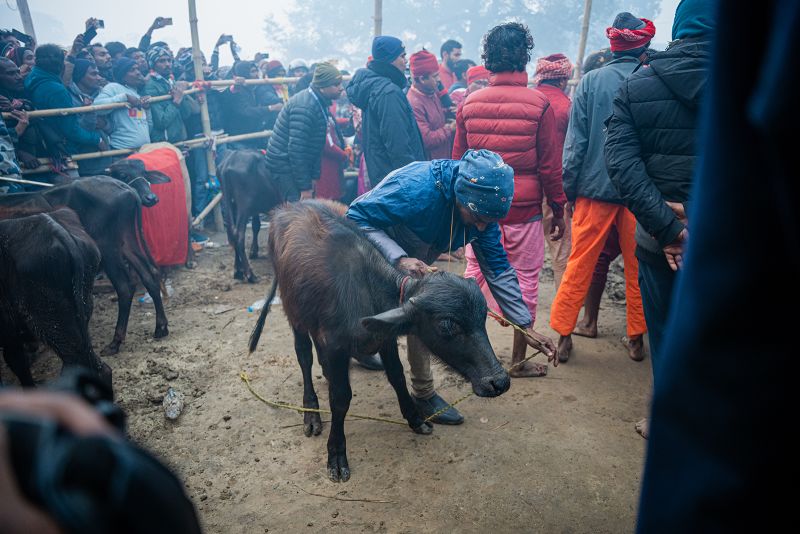Animal rights activists have urged the Nepali government to stop what they’ve called “an appalling bloodbath” after they claimed thousands of animals were killed as part of a festival held every five years that traditionally ends with a mass sacrifice.
At least 4,200 buffaloes and thousands of goats and pigeons were killed during a mass sacrifice held as part of the Gadhimai festival, in Bariyarpur village near the Nepal- India border, according to Humane Society International India (HSI).
Participants believe that sacrificing animals in the Gadhimai temple pleases the Goddess Gadhimai, who will then grant them wishes or good fortune. Animals are also sacrificed to celebrate the birth of sons.
In 2016 Nepal’s supreme court ordered a gradual phasing out of the practice of animal sacrifice that once saw as many as half a million animals killed, but activists say not enough is being done to end it.
“That’s why the sacrifice this year was limited,” he added.
‘They will never be able to stop it’
Animal rights groups have been campaigning to end the slaughter for a decade but have faced resistance from community members who are honoring a custom dating back more than 200 years.
Before the festival, Upendra Kushwaha, 20, said his family has been participating in the event for generations, and would be sacrificing a buffalo this year.
“It happens only once in five years, so we have to do it, it brings goodwill, it keeps us safe,” Kushwaha said.
When asked about the animal rights organizations’ attempt to stop the practice, Kushwaha said: “This is part of our culture, it’s our tradition, they will never be able to stop it.”
Shristi Bhandari, executive director of Jane Goodall Institute Nepal (JGIN), said she understands where the villagers are coming from.
“Animals are sacrificed in various religious rituals in Nepal year-round, so they feel why are they being singled out, why is all this attention, and international attention, on them.”
But Arkaprava Bhar, from HSI, who has witnessed the sacrifice, says it’s the most horrific thing he’s ever seen.
“They have butchers who come and slaughter the buffaloes in a row, it’s a massacre,” he said.
HSI India said that police were also deployed around the temple this year. Yadav, the mayor, said that police had to be deployed for crowd control.
In 2009, before the activists started their campaign, they said some half a million animals were killed, but that had dropped by half during subsequent festivals. This year, they predicted the numbers could soar again, but the figures suggest that hasn’t happened – and their efforts may be paying off.
Volunteers have been working with communities on the ground to discourage them from the practice: sensitizing children in schools, holding community meetings, carrying out awareness drives, and speaking to temple authorities.
All of this together has resulted in some shift in attitudes, Bhandari said.
She said the temple told people they may donate money instead of offering an animal for sacrifice, designating specific amounts for each animal.
“People, particularly women, have started to be more receptive to this and this year the temple has also provided an alternative,” Bhandari said.
“This is a major step, it took years and years of campaigning to get here,” Bhandari said.
A long campaign
Before this year’s festival, animal rights activists mobilized on the border to help Indian police intercept and confiscate animals suspected of being transported to the temple.
Efforts have been focused on the border since a 2014 ruling by the Indian Supreme Court that ordered the Indian government to prevent the illegal crossing of animals.
“We rescued buffaloes from the back of trucks, goats smuggled in scarves on the back of motorbikes, chickens strung upside by their feet on the side of vehicles and baskets and boxes of pigeons,” said Bhar.
“The suffering these animals endure is so upsetting and so unnecessary.”
In all, activists saved more than 750 animals, including 69 buffaloes, 325 goats, 328 pigeons and two chickens, which will be re-homed or released to the wild.
“About 80% of animals come from India so we have been working with the SSB (the Indian central armed police force responsible for patrolling to India-Nepal border) to rescue the animals,” Sneha Shrestha, president of the Federation of Animal Welfare of Nepal said.
However, the border is porous and not all of the trade can be stopped.
“We can only operate at the various checkpoints but villagers know these areas well and take internal routes so we can’t always stop it,” said Bhar of HSI India.
Shrestha works on the Nepal side of the border. Since there’s no outright ban on the slaughter in Nepal, there is little activists can do to push people to stop it, she said.
“We can only talk to people and convince them, we have no authority to take the animals from them,” Shrestha said. “No animal should die in the name of religion or tradition. Temples are not slaughterhouses, and we must not turn them into one.”

